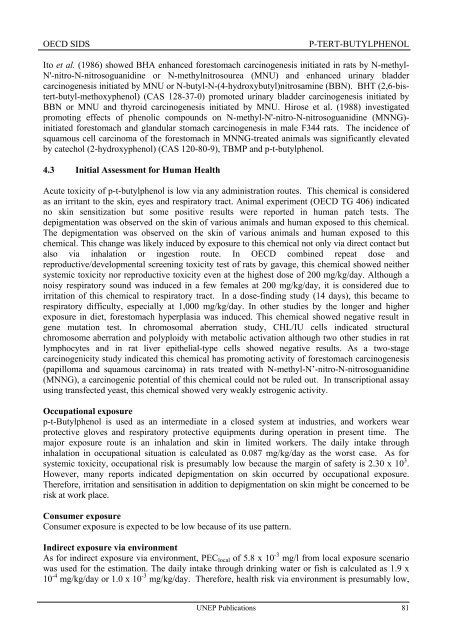p-Tert-Butylphenol - UNEP Chemicals
p-Tert-Butylphenol - UNEP Chemicals
p-Tert-Butylphenol - UNEP Chemicals
You also want an ePaper? Increase the reach of your titles
YUMPU automatically turns print PDFs into web optimized ePapers that Google loves.
OECD SIDS P-TERT-BUTYLPHENOL<br />
Ito et al. (1986) showed BHA enhanced forestomach carcinogenesis initiated in rats by N-methyl-<br />
N'-nitro-N-nitrosoguanidine or N-methylnitrosourea (MNU) and enhanced urinary bladder<br />
carcinogenesis initiated by MNU or N-butyl-N-(4-hydroxybutyl)nitrosamine (BBN). BHT (2,6-bistert-butyl-methoxyphenol)<br />
(CAS 128-37-0) promoted urinary bladder carcinogenesis initiated by<br />
BBN or MNU and thyroid carcinogenesis initiated by MNU. Hirose et al. (1988) investigated<br />
promoting effects of phenolic compounds on N-methyl-N'-nitro-N-nitrosoguanidine (MNNG)initiated<br />
forestomach and glandular stomach carcinogenesis in male F344 rats. The incidence of<br />
squamous cell carcinoma of the forestomach in MNNG-treated animals was significantly elevated<br />
by catechol (2-hydroxyphenol) (CAS 120-80-9), TBMP and p-t-butylphenol.<br />
4.3 Initial Assessment for Human Health<br />
Acute toxicity of p-t-butylphenol is low via any administration routes. This chemical is considered<br />
as an irritant to the skin, eyes and respiratory tract. Animal experiment (OECD TG 406) indicated<br />
no skin sensitization but some positive results were reported in human patch tests. The<br />
depigmentation was observed on the skin of various animals and human exposed to this chemical.<br />
The depigmentation was observed on the skin of various animals and human exposed to this<br />
chemical. This change was likely induced by exposure to this chemical not only via direct contact but<br />
also via inhalation or ingestion route. In OECD combined repeat dose and<br />
reproductive/developmental screening toxicity test of rats by gavage, this chemical showed neither<br />
systemic toxicity nor reproductive toxicity even at the highest dose of 200 mg/kg/day. Although a<br />
noisy respiratory sound was induced in a few females at 200 mg/kg/day, it is considered due to<br />
irritation of this chemical to respiratory tract. In a dose-finding study (14 days), this became to<br />
respiratory difficulty, especially at 1,000 mg/kg/day. In other studies by the longer and higher<br />
exposure in diet, forestomach hyperplasia was induced. This chemical showed negative result in<br />
gene mutation test. In chromosomal aberration study, CHL/IU cells indicated structural<br />
chromosome aberration and polyploidy with metabolic activation although two other studies in rat<br />
lymphocytes and in rat liver epithelial-type cells showed negative results. As a two-stage<br />
carcinogenicity study indicated this chemical has promoting activity of forestomach carcinogenesis<br />
(papilloma and squamous carcinoma) in rats treated with N-methyl-N’-nitro-N-nitrosoguanidine<br />
(MNNG), a carcinogenic potential of this chemical could not be ruled out. In transcriptional assay<br />
using transfected yeast, this chemical showed very weakly estrogenic activity.<br />
Occupational exposure<br />
p-t-<strong>Butylphenol</strong> is used as an intermediate in a closed system at industries, and workers wear<br />
protective gloves and respiratory protective equipments during operation in present time. The<br />
major exposure route is an inhalation and skin in limited workers. The daily intake through<br />
inhalation in occupational situation is calculated as 0.087 mg/kg/day as the worst case. As for<br />
systemic toxicity, occupational risk is presumably low because the margin of safety is 2.30 x 10 3 .<br />
However, many reports indicated depigmentation on skin occurred by occupational exposure.<br />
Therefore, irritation and sensitisation in addition to depigmentation on skin might be concerned to be<br />
risk at work place.<br />
Consumer exposure<br />
Consumer exposure is expected to be low because of its use pattern.<br />
Indirect exposure via environment<br />
As for indirect exposure via environment, PEClocal of 5.8 x 10 -3 mg/l from local exposure scenario<br />
was used for the estimation. The daily intake through drinking water or fish is calculated as 1.9 x<br />
10 -4 mg/kg/day or 1.0 x 10 -3 mg/kg/day. Therefore, health risk via environment is presumably low,<br />
<strong>UNEP</strong> Publications 81
















